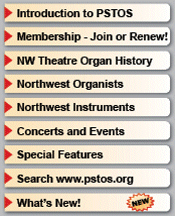Earl D. Pavette (1889-193x)
According to Bill Bunch, Earl Pavette started out helping Sandy Balcom with the installation of Kimball theatre organs in the 1920's. He later struck out on his own representing Moller for a short time and even built one complete instrument for the Kent Theatre in Kent, Washington. Mr. Pavette died in the 1930s.
The following article appeared in the September 25, 1928 Seattle Post-Intelligencer newspaper and was supplied by Bill Bunch and Sandy Balcom to David Junchen for inclusion in the Encyclopedia of the American Theatre Organ, Volume II. The clipping is now back in the PSTOS chapter archives.
Click to see the original article
 |

Earl D. Pavette Reveals New Mechanical Principles for Instrument Constructed By Self
What may be the beginning of a factory for the construction of pipe organs in Seattle and fame for a local man is seen today in the little back yard shop of Earl D. Pavette, 1023 East Ninety-second Street.
Pavette, with years of experience in this work in America's biggest pipe organ plants, has built a $12,000 instrument, said to be the first of its kind wholly constructed in the state, which will soon be installed in the Kent Theatre at Kent.
But though he has been successful in this venture and is in all probability the pioneer in this work here, that is the smallest feather in Pavette's cap. He prides himself in having achieved success with new mechanical principles of his own. |

 |
BUILT HIS CONSOLE
The console he built entirely himself. The hundreds of pipes, the harp and various tone projectors he had specially built after his own design in the East. Then he did his own assembling after his own new system.
The chief new departure in Pavette's instrument is a single valve action system on the pipes, which, he said, produces superior results in speed, touch and reproduction in addition to cuting the cost of construction almost in half. And in his four distinct basic tones Pavette has achieved such unification as to give virtually an unlimited variety of tones perfectly blended.
HIGH WIND PRESSURE
"Yes, the manufacturers thought I was crazy, and only built them under protest," he explained yesterday. "But representatives sent out by them to see the finished product have made an apology."
Another innovation of Pavette's incorporation is high wind pressure, giving instantaneous reproduction of tone as the player strikes the keys. This, with direct magnet connection to the pipes, gives action faster than in the piano.
Pavette also has succeeded, he believes, in producing the ideal traps and drums sounds heretofore imperfectly developed in the pipe organ.
FROM CINCINNATI
Pavette, thirty-nine, came to Seattle from Cincinnati in 1912 and since then has been employed by organ manufacturers to do their installing in this district. He started his career with a small organ manufacturering company in St. Louis at the age of fourteen. For eight years before coming West he was with the Wurlitzer Company and the John Church Company.
Some day he hopes to organize a pipe organ manufacturing business in Seattle, he said. But first he's going to let Kent theatre audiences pass critical inspection on his first instrument.
|





